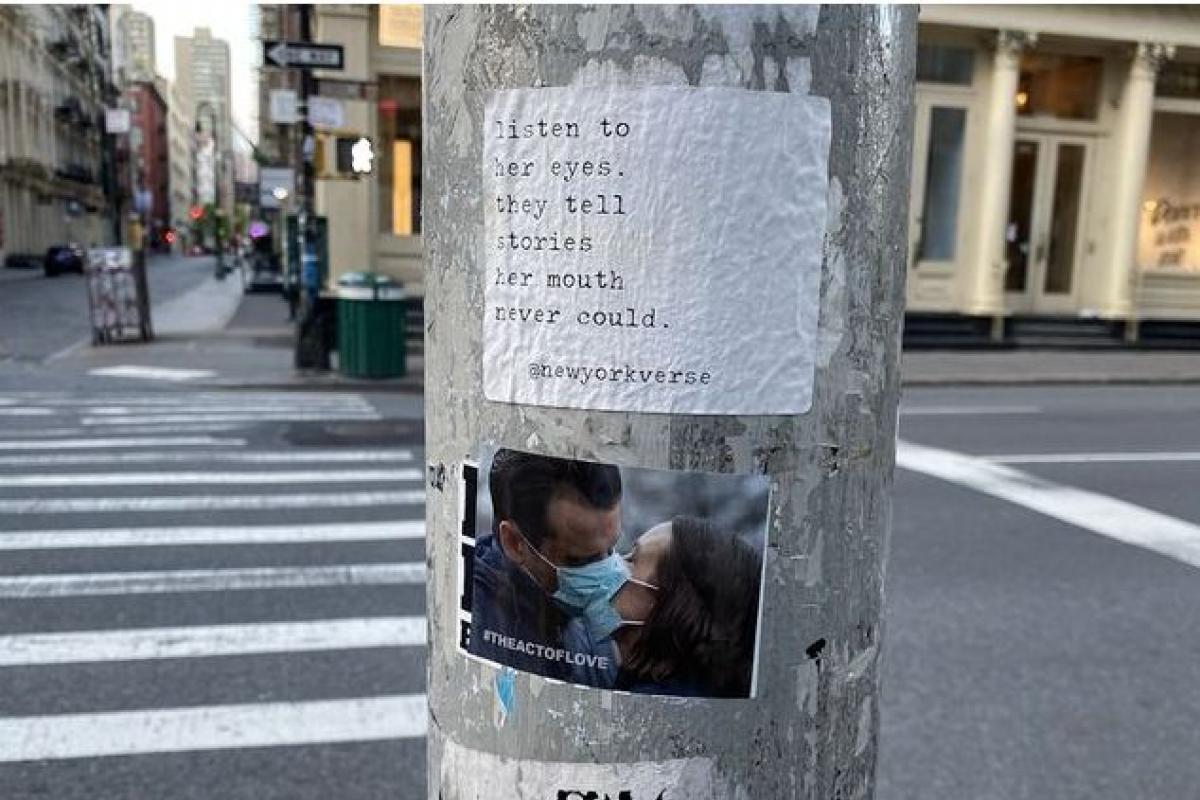Unité 10 | Ressource Texte

How NYC’s Street Artists Have Responded To The Pandemic
An article about the way New York's street artists reacted to the Covid-19 pandemic.
How NYC’s Street Artists Have Responded To The Pandemic
In early March 2020, around the time New York City had gotten its first confirmed coronavirus case, artist Arina Voronova had an evangelical impulse. “I wanted to deliver a direct message to people who live in the city and I wanted this message to spread.” [...]
Voronova decided to push back through her art. She took a series of photos of people of all ages, races, and sexual orientations wearing light blue surgical masks. The twist was they were kissing: woman and woman, mother and child, friends of hers and strangers she’d just walked up to on the street — kissing with an almost eerie1 tenderness that seemed to defy the emergency that was beginning to engulf us.
She turned the photos into posters and stickers, and spent many days and nights putting them up around Manhattan, beginning with a plywood2 construction fence in Chinatown. Her message might seem obvious now, but it was striking at the time: “We live in a society so we have to wear masks, but we are still connected and can spread kindness,” as she described it recently. [...]
Sean Corcoran, curator of print and photographs at the Museum of the City of New York, knew that pandemic art was likely to be busting out all over, even though he was stuck in his Park Slope apartment and couldn’t roam around to look for it. So he asked for help via the museum’s social media accounts, which asked followers to keep an eye out for COVID-themed murals, stenciled images, and wheat-pasted posters when they ventured out into the wild. [...]
The museum’s campaign helped to reveal that there was more than enough art for an exhibition, which is open now at the museum and called ‘New York Responds’. Corcoran said the emergence of street art on social media gained even more momentum as the world languished in quarantine, scrolling in search of visual stimulation. “People in Paris could see what was happening on the streets of New York just as easily as I could in Brooklyn.” [...]
Steve Harrington, who runs Brooklyn Street Art with Jamie Rojo, said street art’s bedrock3 ethic is engagement with the physical city — of doing your thing pseudonymously and leaving it for passersby to find. Artists alter the urban landscape with their works, which the rest of us register, sometimes subconsciously, as we commute or run errands or just wander around the neighborhood. But it became clear to Harrington early on in the pandemic that something new was happening — that, “Social media was going to be far more important in spreading the messages of street artists than streets.” [...]
That purpose is not unique to New York; in fact, said the MCNY’s Corcoran, it has worked this way since the heyday4 of Pompeii. “A lot of the graffiti that was found in Pompeii was political, against the government in ancient Rome,” he said. “It’s long been a way for the people to have their say.”
www.gothamist.com, March 24th, 2021
1. unusual
2. layered wood panel
3. base
4. greatest time
Questions :
1. Draw a four-column grid to fill in with the people mentioned (names and occupation), their response to the pandemic and the reasons why they did it.
2. List the roles social media played during the pandemic.
3. Comment on the following sentences “A lot of the graffiti that was found in Pompeii was political, against the government in ancient Rome,” he said. “It’s long been a way for the people to have their say.”
4. On the same model as the artists you studied, explain what your own initiative would be if you were a NY street artist.
Crédits :
How NYC's Street Artists Have Responded To The Pandemic, by JIM O'GRADY, WNYC, MARCH 24, 2021, gothamist.com © 2021 NEW YORK PUBLIC RADIO, D.R.

